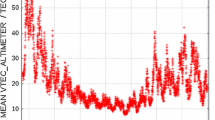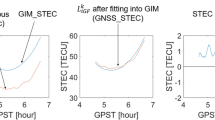Abstract
A summary of the main concepts on global ionospheric map(s) [hereinafter GIM(s)] of vertical total electron content (VTEC), with special emphasis on their assessment, is presented in this paper. It is based on the experience accumulated during almost two decades of collaborative work in the context of the international global navigation satellite systems (GNSS) service (IGS) ionosphere working group. A representative comparison of the two main assessments of ionospheric electron content models (VTEC-altimeter and difference of Slant TEC, based on independent global positioning system data GPS, dSTEC-GPS) is performed. It is based on 26 GPS receivers worldwide distributed and mostly placed on islands, from the last quarter of 2010 to the end of 2016. The consistency between dSTEC-GPS and VTEC-altimeter assessments for one of the most accurate IGS GIMs (the tomographic-kriging GIM ‘UQRG’ computed by UPC) is shown. Typical error RMS values of 2 TECU for VTEC-altimeter and 0.5 TECU for dSTEC-GPS assessments are found. And, as expected by following a simple random model, there is a significant correlation between both RMS and specially relative errors, mainly evident when large enough number of observations per pass is considered. The authors expect that this manuscript will be useful for new analysis contributor centres and in general for the scientific and technical community interested in simple and truly external ways of validating electron content models of the ionosphere.










Similar content being viewed by others
Change history
16 March 2020
In the original publication of the articles, ���Methodology and consistency of slant and vertical assessments for ionospheric electron content models��� and ���Consistency of seven different GNSS global ionospheric mapping techniques during one solar cycle���, a common typo affecting the text only (not the computations) has been recently noticed. It compromised the definition of the scaling factor from Global Navigation Satellite Systems ionospheric delay to electron content is clarified in this erratum.
Notes
This typical maximum error can be deduced from the 2 mm of nominal carrier phase measurement noise (see page 4.15 in Wells et al. 1987), the definition of geometry-free combination of both carrier phases L1-L2, and the two STEC measurements involved in dSTEC, after taking into account that the carrier phase multipath is typically very small.
Being \(M=1/\sqrt{1-r^2\cos ^2 E/r^2_{I}}\) the mapping function, where r and \(r_I\) are the geocentric distances of the receiver and the ionospheric pierce point (in our case the Earth radius plus 450 km) respectively, and E is the elevation angle of the satellite above the receiver spherical horizon (see, for instance, Equation 32 in Hernández-Pajares et al. 2011).
References
Azpilicueta F, Brunini C (2009) Analysis of the bias between topex and gps vtec determinations. J Geod 83(2):121–127
Bruyninx C (2004) The euref permanent network: a multi-disciplinary network serving surveyors as well as scientists. GeoInformatics 7(5):32–35
Colombo OL, Hernandez-Pajares M, Juan JM, Sanz J (2002) Wide-area, carrier-phase ambiguity resolution using a tomographic model of the ionosphere. Navigation 49(1):61–69
Dow JM, Neilan R, Rizos C (2009) The international gnss service in a changing landscape of global navigation satellite systems. J Geod 83(3–4):191–198
Feltens J (2007) Development of a new three-dimensional mathematical ionosphere model at european space agency/european space operations centre. Space Weather 5(12):1–17
Feltens J, Angling M, Jackson-Booth N Jakowski N Hoque M Hernández-Pajares M Aragón-Àngel A Orús R Zandbergen R (2011) Comparative testing of four ionospheric models driven with gps measurements. Radio Sci 46(6):1–11
Feltens J (2003) The activities of the ionosphere working group of the international gps service (igs). GPS Solut 7(1):41–46
Galvan DA, Komjathy A, Hickey MP, Stephens P, Snively J, Tony Song Y, Butala MD, Mannucci AJ (2012) Ionospheric signatures of tohoku-oki tsunami of march 11, 2011: model comparisons near the epicenter. Radio Sci 47(4):1–10
Ghoddousi-Fard R, Héroux P, Danskin D, Boteler D (2011) Developing a gps tec mapping service over Canada. Space Weather 9(6):1–10
Hernández-Pajares M et al (2010) Section 9.4 ionospheric model for radio techniques of chapter 9 models for atmospheric propagation delays of IERS conventions 2010. IERS Technical Note
Hernández-Pajares M, Juan J, Sanz J (1999) New approaches in global ionospheric determination using ground gps data. J Atmos Sol Terr Phys 61(16):1237–1247
Hernández-Pajares M, Juan J, Sanz J, Orus R, Garcia-Rigo A, Feltens J, Komjathy A, Schaer S, Krankowski A (2009) The igs vtec maps: a reliable source of ionospheric information since 1998. J Geod 83(3–4):263–275
Hernández-Pajares M, Juan J, Sanz J, Aragón-Àngel A (2012) Propagation of medium scale traveling ionospheric disturbances at different latitudes and solar cycle conditions. Radio Sci 47(6):1–22
Hernández-Pajares M (2004) IGS ionosphere WG status report: performance of IGS ionosphere TEC maps-position paper. In: IGS workshop, Bern
Hernández-Pajares M, Juan J, Sanz J, Colombo OL (2000) Application of ionospheric tomography to real-time gps carrier-phase ambiguities resolution, at scales of 400–1000 km and with high geomagnetic activity. Geophys Res Lett 27(13):2009–2012
Hernández-Pajares M, Juan JM, Sanz J, Aragón-Àngel À, García-Rigo A, Salazar D, Escudero M (2011) The ionosphere: effects, gps modeling and the benefits for space geodetic techniques. J Geod 85(12):887–907
Hernández-Pajares M, Aragón-Ángel À, Defraigne P, Bergeot N, Prieto-Cerdeira R, García-Rigo A (2014) Distribution and mitigation of higher-order ionospheric effects on precise gnss processing. J Geophys Res Solid Earth 119(4):3823–3837
Hernández-Pajares M, Roma-Dollase D, Krankowski A, Ghoddousi-Fard R, Yuan Y, Li Z, Zhang H, Shi C, Feltens J, Komjathy A, Vergados P, Schaer S, Garcia-Rigo A, Gmez-Cama JM (2016) Comparing performances of seven different global VTEC ionospheric models in the IGS context. In: IGS workshop, Feb 8–12, 2016, Sydney, Australia, International GNSS Service (IGS), pp 1–31. International GNSS Service (IGS)
Hudnut KW, Bock Y, Galetzka JE, Webb FH, Young WH (2001) The southern California integrated GPS network (SCIGN). In: The 10th FIG international symposium on deformation measurements, Orange California, USA, pp 19–22. Orange California, USA
Janssen V, White A, Yan T (2010) CORSnet-NSW: towards state-wide CORS infrastructure for New South Wales, Australia. In: FIG Congress 2010, pp 1–14
Juan J, Hernández-Pajares M, Sanz J, Ramos-Bosch P, Orus R, Ochieng W, Feng S, Jofre M, Coutinho P, Samson J et al (2012) Enhanced precise point positioning for gnss users. IEEE Trans Geosci Remote Sens 50(10):4213–4222
Li Z, Yuan Y, Wang N, Hernandez-Pajares M, Huo X (2015) Shpts: towards a new method for generating precise global ionospheric tec map based on spherical harmonic and generalized trigonometric series functions. J Geod 89(4):331–345
Mannucci A, Wilson B, Yuan D, Ho C, Lindqwister U, Runge T (1998) Global mapping technique for gps-derived ionospheric total electron content measurements. Radio Sci 33(3):565–582
Orús R (2005) Contributions on the improvement, assessment and application of the global ionospheric vtec maps computed with gps data. Doctoral dissertation, Ph. D. dissertation. Doctoral Program in Aerospace Science & Technology
Orús R, Hernández-Pajares M, Juan J, Sanz J (2005) Improvement of global ionospheric vtec maps by using kriging interpolation technique. J Atmos Sol Terr Phys 67(16):1598–1609
Rovira-Garcia A, Juan JM, Sanz J, Gonzalez-Casado G (2015) A worldwide ionospheric model for fast precise point positioning. IEEE Trans Geosci Remote Sens 53(8):4596–4604
Sagiya T (2004) A decade of geonet: 1994–2003 the continuous gps observation in japan and its impact on earthquake studies. Earth Planets Space 56(8):29–41
Schaer S (1999) Mapping and predicting the earths ionosphere using the Global Positioning System. 1999, p 205, Ph.D. thesis, Ph. D. dissertation. University of Bern, Bern, Switzerland
Schaer S, Beutler G, Rothacher M, Springer TA (1996) Daily global ionosphere maps based on GPS carrier phase data routinely produced by the CODE Analysis Center, In: Proceedings of the IGS AC Workshop, Silver Spring, MD, USA, pp 181–192
Snay RA, Soler T (2008) Continuously operating reference station (cors): history, applications, and future enhancements. J Surv Eng 134(4):95–104
Talaya J, Bosch E (1999) CATNET, a permanent GPS network with real-time capabilities. In: Proceedings of ION GPS-99, 12th international technical meeting of the satellite division of The US Institute of Navigation, pp 14–17
Wells D, Beck N, Kleusberg A, J.Krakiwsky E, Lachapelle G, Langley RB, Schwarz K-p, Tranquilla JM, Vanicek P, Delikaraoglou D (1987) Guide to GPS positioning. In: Canadian GPS Assoc, Citeseer. Citeseer
Zhang H, Xu P, Han W, Ge M, Shi C (2013) Eliminating negative vtec in global ionosphere maps using inequality-constrained least squares. Adv Space Res 51(6):988–1000
Acknowledgements
The authors acknowledge the contribution of the four active IGS ionospheric analysis centres, in particular CODE, ESA-ESOC and JPL, for their continuous effort and improvement in their support of the combined IGS GIMs as far as the new analysis centres, NRCAN, CAS and WHU, contributing to IIWG. The English improvements suggested by Mr. Kacper Kotulak are very appreciated as well.
Author information
Authors and Affiliations
Corresponding author
Rights and permissions
About this article
Cite this article
Hernández-Pajares, M., Roma-Dollase, D., Krankowski, A. et al. Methodology and consistency of slant and vertical assessments for ionospheric electron content models. J Geod 91, 1405–1414 (2017). https://doi.org/10.1007/s00190-017-1032-z
Received:
Accepted:
Published:
Issue Date:
DOI: https://doi.org/10.1007/s00190-017-1032-z




